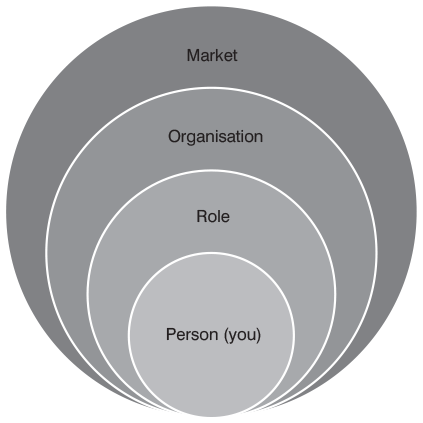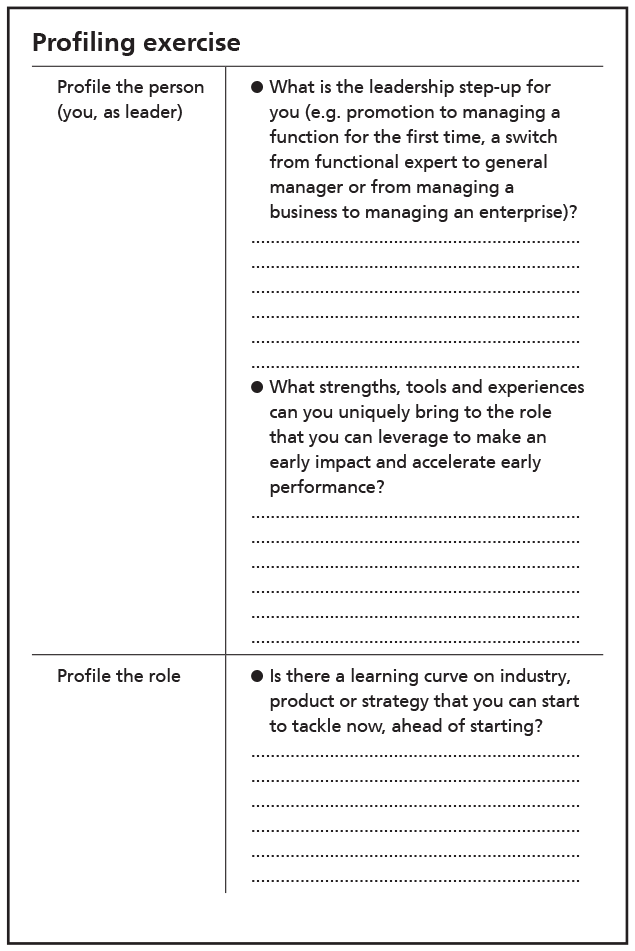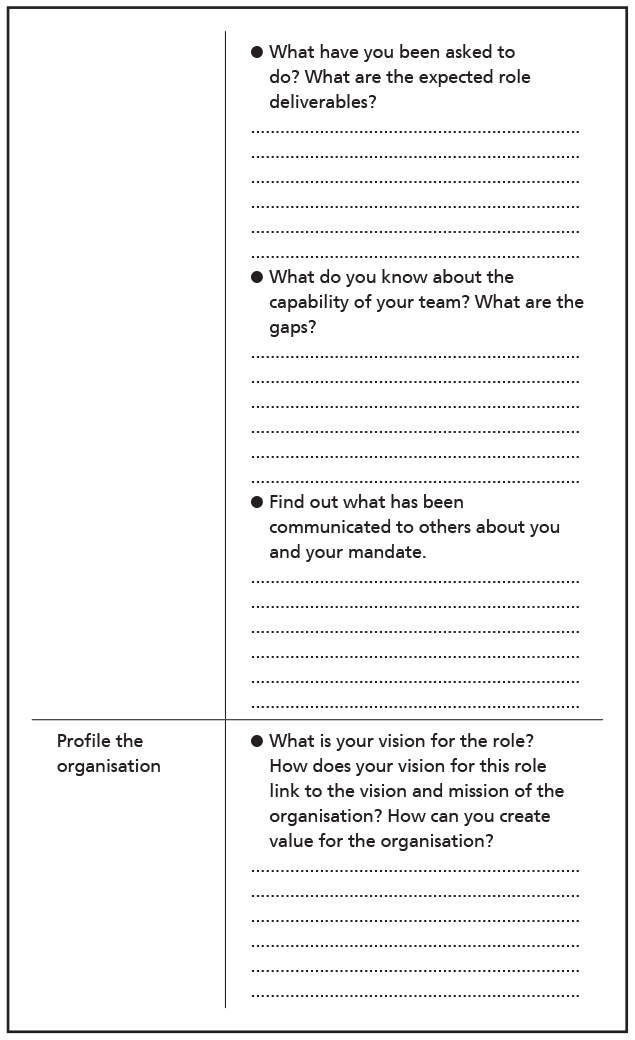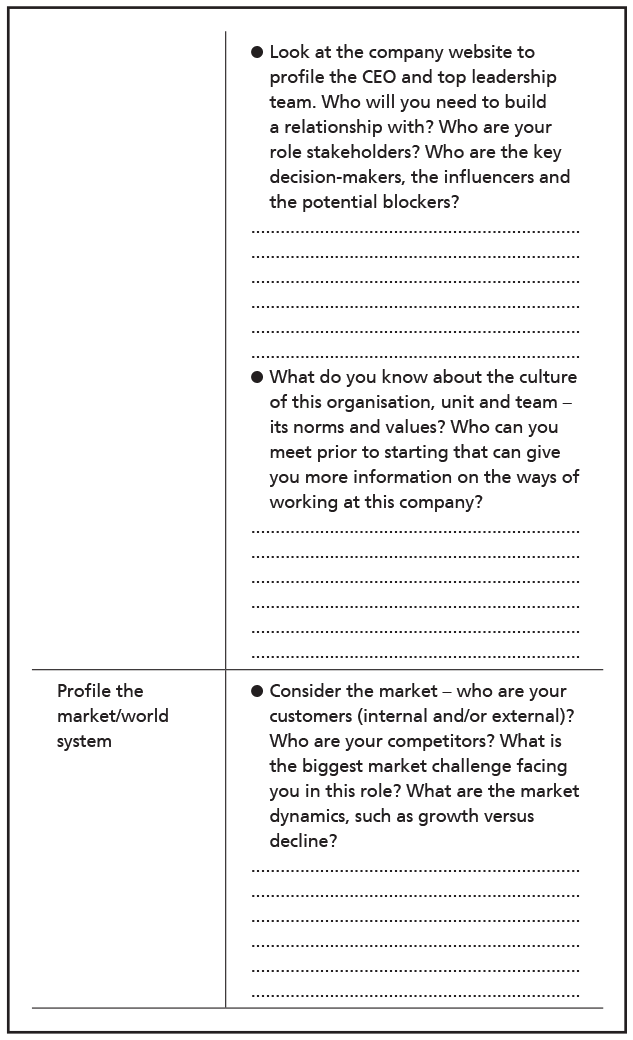@ pre-start
- Let go of your previous role
- Set up your energy management system
- Understand the transition challenges
- Profile your role, organisation and market
- Prepare to meet your team and get them ready for your arrival
- Executive coaching Q&A: advice on issues and scenarios @ pre-start
1 Let go of your previous role
Saying your first step is to hand over your current role may seem like stating the obvious but, in my experience, people do not detach fast enough from their previous role. You know exactly what is expected of you in your current role, and you may have established a high-functioning working relationship with your boss. To go from that scenario to having a new challenging role and a new boss may take you completely out of your comfort zone.
Initially – although you say you really want the new role change – it can feel easier to hedge for a while. You may even deliberately or unconsciously resist the move by putting all sorts of barriers in the way of a new role offer: ‘I can’t start yet. I need more time. My boss will never let me go’ etc.
People stay involved in their previous role for all the wrong reasons:
- Emotional ties to team
- Preference to stay in comfort zone
- Concern about wrapping up everything before they go
- False belief that no one else could be good enough to take over
Don’t sabotage a great new opportunity. Get your head around the fact that no one is indispensable. You can be replaced. Let go and move on. Letting go of current attachments as quickly as possible is a crucial first step because you need to refocus all your time, energy and thoughts on the new role. So, remember, however committed a person you are, your last role was your responsibility, but it is not your responsibility any more. As soon as you have notice of your new role, start to close out the previous role immediately. I always check that my clients are 100 per cent detached from their old role, and 100 per cent focused on the new role. Otherwise, we are off to a slow start.
it is over, so hand it over
Obviously when you’re an internal appointment, the letting go can be understandably harder than for an external person that contractually leaves their company and physically leaves a building.
Your internal transition may also be tougher if you are expected to do both roles until your successor is found. Accelerating success in your first 100 days is already compromised if you are attempting to overlap two jobs at once. So what can an internal person do to get off to an accelerated start in the first 100 days?
Those who are internal promotes need to be very assertive and artificially recreate the same context of an external hire:
- Negotiate a clear finishing date for current role.
- Appoint an interim if your successor is not in situ and fully hand over.
- Agree a formal starting date of new role, and don’t start until then.
2 Set up your energy management system
The first 100 days is an intense phase. All eyes are on you and there is considerable pressure to make a big impression and deliver results fast. So, in preparation, try to create time in between roles to rest, recover from your previous role and get ready for the new challenge ahead. Think of yourself as a corporate athlete resting between serious races.
If possible, take a break in between roles. This will clear your head from the old role and heighten energy levels and perspective coming into the first 100 days of the new role. You need to be fit for purpose, with a surplus of energy to take on a new role and make a strong early impact.
Table 1.1 Energy management in your first 100 days
| Take care of your mind | Before, during and after work, schedule enough time and space to be on your own so that you can relax and release the build-up of pressure. |
| Take care of your body | Exercise routinely, eat healthy and nutritious food. Try to build up extra reserves in your system. |
| Enlist others to support you | Get third-party help. Find an internal mentor. Hire an executive coach. Negotiate extra support and latitude from loved ones. Maintain a calm and nurturing personal life. |
Don’t think that this next 100 days is business as usual in your personal life. Starting a new role is a heightened stress event. Adrenalin will compensate for any lack of reserves, but don’t exacerbate the pressure on you by having the house redecorated or the in-laws coming for a visit. Keep a cool, clear head and maintain a calm personal life if you want to enjoy accelerated success in the first 100 days.
Earlier in my executive coaching career I noticed a pattern of leaders feeling poorly during their first 100 days. It typically presents itself as my clients telling me, in passing, that they have a ‘major cold’. And it is always accompanied with an air of surprise: ‘I’m never usually ill.’
It was being mentioned as if it was a completely separate event, and not linked to the context of the heightened stress from taking up a new job – demonstrating a total lack of awareness of the cause (major stress) and effect (major cold).
Now I proactively educate my clients to acknowledge that what is going on in their bodies can represent a physical manifestation or fallout from the challenge of the first 100 days. We get ahead of the curve, by adopting tactics to manage or mitigate rising stress levels early. Having a first 100 days plan helps clients to feel more confident and in control and less stressed. But also I encourage them to make time for mind-calming exercise at the weekends, such as golf or yoga. I also suggest they carve out some regular quiet time on their own during the working day to calm the mind and reset their priorities. This can be as little as 15 minutes in the morning and 15 minutes again in the afternoon – and yet the benefits are amazing in terms of the effect of keeping you calm and centered on the right priorities for the whole day.
3 Understand the transition challenges
The primary task for the executive targeting first 100 days success is to set out the right strategic priorities and stay focused on them. Sounds simple? Unfortunately, it is easier said than done. There is a list of common challenges inherent in every transition that will affect the newly appointed executive. These can derail good intentions and get in the way of successfully achieving that primary task.
Here are some of the common transition challenges:
- Time pressures and intense learning curve.
- Being overwhelmed with immediate fire-fighting and task-driven priorities.
- A need to invest energy in building new networks and forging new stakeholder relationships.
- Dealing with legacy issues from the predecessor.
- Challenges of inheriting or building a team and having to make tough personnel decisions.
- For external appointments, a lack of experience of the new company culture may lead to inadvertent gaffes and early political blunders – all of which can take time to recover from.
- Getting the balance right between moving too fast and moving too slowly.
Each one is worthy of consideration, so read through the list and take some time to reflect on how each of these transition challenges applies to your context. Go through the list in Table 1.2 and apply each one to your own circumstances to gain a greater appreciation of what lies ahead for you.
Table 1.2 Transition challenges
Patient preparation and adequate awareness of what you are facing is the first step. At the beginning stage, if you can take time out to understand all the transition challenges that you face, then the sooner you can start to equip yourself with insights and ideas on how to overcome or deal with them. Understanding your transition challenges is an exercise that starts to form the backdrop for developing your first 100 days plan.
4 Profile your role, organisation and market
In addition to understanding your transition challenges, step back and take a wide-lens view of the whole system within which you will be operating. See it is as a construct where you are at the centre: person (you, as leader), in a role, in an organisation, and set in the context of your marketplace.
Build up a profile of each part of this system to map out the landscape of your opportunities and challenges. Remember to take advantage of this beginning phase. After all, this is the most clear-headed you will be because soon you will be mired in the detail and day-to-day requirements of the role. Now is the time to understand the big picture. Survey the whole system landscape with as much perspective as possible, and continue to draw out information and insights on what lies ahead of you.
Figure 1.1 The whole-system approach


Using the clues gathered in the profiling exercise, take time to think widely and deeply to build up the picture of what you are facing, so that you understand more quickly how to navigate the whole system in the first 100 days.
At this beginning phase, don’t rush to judgment too early. You may have some information at this stage but, remember, you have not met all the players yet, and you don’t have experience of the actual role yet. Be like a detective who has clues, but not yet all of the information pieced together. Find the right balance of building up a profile of what is ahead and, at the same time, reserve final judgment so that you can wisely allow reality and your own personal experience to adjust your perspective once you have started.
First100™ client case study
Although he had never previously considered getting third-party help, Ashley was very relieved when a colleague recommended a First100 expert he could talk to about his new role challenges. During his first session, Ashley was surprised at the experience and candour of the First100 coach. As Ashley read the session notes afterwards, he realised that he had a lot to learn if he wanted to make a successful leadership step-up.
‘It’s okay to admit that you are feeling under pressure’
Coach notes from Session 1
As a coach, there is nothing more worrying than meeting a client who is under pressure prior to starting a new job, trying to convince them and others that they are not under pressure. It raises red flags – makes me wonder if the person has any coping techniques other than trying to pretend that nothing is wrong. Admitting you’re under pressure is a good thing for you and any senior executive to do. Otherwise, you are blocking out reality and not developing strategies to deal with a very intense job.
Every leader needs to have a suite of coping techniques to alleviate pressure because a leader’s job always involves pressure – techniques can range from time with family and friends, to sport, to quiet time alone, walking the dog, practising meditation or scheduling regular 20-minute time-out breaks during the working day.
Denial as a coping method is the kind of macho behaviour that leads men into sudden heart attacks. So let’s get more real: it is okay to say you’re under pressure. Put it another way – how could you not be? You’re the newly appointed Global Head of Sales for Premium Services at your bank, but your predecessor has left without a proper handover, you are massively under-resourced from a people perspective, you need to quickly build crucial relationships with important Asian stakeholders, you are concerned about hitting the quarterly numbers, you have the stress of moving offices, you’re probably still jet-lagged from recent trips abroad and you said you’re finding it difficult to sleep.
So, admit it, accept it, say it out loud… ‘I feel under pressure. I feel overwhelmed. It’s a whirlwind and it can feel out of control.’
Doing anything else makes you seem ungrounded, unrealistic and unable to face the truth.
However, if you accept it, then you have to do something about it. If you accept that you are under pressure, then you will have to start using techniques to alleviate the pressure. You will then start to alleviate and release the pressure – and like night follows day, you will feel better and start to perform better.
Ashley had felt overwhelmed by his new responsibilities on his way into the coaching session, but had to acknowledge that he felt much calmer on the way out. Accepting that he felt under more pressure than usual was an unexpected relief in itself. It was time to take charge, and stop that feeling of overwhelm from returning and getting in the way of his performance. The coach had given Ashley a very structured profiling approach and some clever ideas on how to adequately prepare for the role. Feeling better equipped on where to start, Ashley sat at his desk and started to apply the information to his new role situation.
5 Prepare to meet your team and get them ready for your arrival
Building and leading a high-performing team will be critical to your success in the first 100 days. However, establishing yourself as a leader of a team can feel like a daunting task:
- Do I have the right people?
- Will I make a good impression?
- How will the team respond to me?
- What challenges lie ahead with this team?
- What do they expect from me as their new boss?
The hierarchy requirement whereby you need to establish yourself as the boss and command respect from others – sometimes former peers – might make you feel very apprehensive. But remember that your job is to be a boss and a leader and it’s not a popularity contest. If people like you, that’s great – as likeability can be helpful as an extra motivational tool. However, the focus is not about being liked.
Your focus as a boss is to set direction, give appropriate guidance and make reasonable demands of your people. You can balance this out by also being highly responsive to the needs and motivations of team members. However, in the same way that your role is not to be authoritarian, your role is also not to be indulgent or negligent. In the end, leaders who rank high in demandingness and rank high in responsiveness will achieve the best results with their team.
Pre-arrival announcement template
Keep the tone confident, reassuring, open and professional. In this example, Ashley sets an expectation of mutual dialogue, open communication, high standards and that he intends to hit the ground running. It offers a glimpse into Ashley’s personal life, which helps people relate to him.
Hello everyone
My name is Ashley Morgan.
As John announced recently, I am the new Global Head of Sales for Premium Services. I officially start on 1st September. Some of you already know me, but I thought it might be helpful to introduce myself to everyone in advance.
It’s a privilege to take up this leadership role. I have worked with Zintech since 2012 and most recently served as the UK Director of Sales since 2016. On a more personal level, I live in London with my wife and two children and family is very important to me. The kids certainly keep me active outside work. They also keep me grounded on how important it is to find the right balance between work and personal life.
I want to acknowledge the great work of Fiona and her team in creating a very successful and profitable unit. I invite you to tweet, write or call me with your ideas, reflections and suggestions on how we build on your success to date.
We have a fantastic opportunity ahead of us – and I look forward to meeting you all and working with you. See you at the team social event in a few weeks and in the meantime George is scheduling a series of one-to-one meetings ahead of our first team workshop in September.
Let’s get connected!
Ashley
Social media:
Mobile:
Email:
As soon as your role announcement is made public, you can be sure that members of your team will immediately conduct a thorough online search of your name. It would be a good idea for you to have done the same. Check your social media and online profile. What comes up when you search under your name? What kind of impression does it send? If there is anything you need to delete, or tidy up, then do it. If there is anything unusual or requires further explaining, be ready to do so.
EMPATHISE WITH YOUR TEAM’S EMOTIONS
Realise that your team members are experiencing both excitement and trepidation about your arrival. After all, you now have direct influence and control over whether they continue to enjoy coming to work every day, and you have the most impact on whether or not they achieve their next promotion. They didn’t pick you and yet here you are. It may be true to say that their predicament is more anxiety-inducing than yours. Understanding how your team may be feeling is an important beginning of your empathetic relationship with them, and will help accelerate leader-team bonding.
Let us take a sneak peek into the mind of your team, to see what they may be thinking:
- Who is this person?
- Will I like them?
- Will they like me?
- Why didn’t I get the job?
- What does this mean for my career?
- Will I bother to stick around? Might this be a good time to leave?
You are not the only one with emotional reactions and concerns about this new relationship. Remember you have got the job, but these guys don’t know if they will still have their job in three months’ time. That’s a bigger jeopardy for them. Be aware that you may have some ‘flight risks’ – team members who have been jolted out of their status quo by their boss leaving and may be thinking of resigning and possibly joining your predecessor in their new company.
Keep all this in mind, so that you don’t become overly consumed with your own concerns. Leave room for building empathy and considering the feelings of others too. The flight risks will be seeking your reassurance that you are committed to their personal success, that you are a good leader, and somebody they can learn from and that it is worth sticking around.
PREPARE TO MEET YOUR TEAM
Working with your new boss and HR, you can do a lot of advance research on the profile and history of the team you are inheriting. Ask questions, do your homework.
- Profile your team.
- Names and biographies of key reports.
- Request an updated team organisation structure chart, with role titles and names.
- How many direct reports, dotted lines and virtual team members?
- Check the geographic spread, full-time versus part-time workers, number of home-workers, any maternity leavers and any planned retirements.
- Copies of the last round of performance appraisals and rankings of each person.
- Any available psychometric or behavioural profiles of individuals or of the team.
- Identify any gaps and role vacancies on the team:
- Recruitment activities or executive searches, if any, are underway.
- Searches that need to be launched.
- Understand company HR processes, timings and perception of the team:
- How does the company’s annual performance appraisal cycle work?
- Who is in line for promotion, and what is the HR view on the performance and potential of each person?
- How does this group work as a team? Any known conflicts or personality clashes?
- Prepare your launch speech or introduction presentation to your team:
- Your career background/story and why you took up this role.
- Your leadership philosophy, values and any principles.
- Preferred ways of working, processes and approach.
Check how much scope you have to bring in fresh talent from your previous team, the wider internal pool and from the external market. Don’t assume that you can’t change the structure and composition of your key report team. It is most likely that as you get a sense of the challenges ahead and clarity on your team mission you will want to make changes and re-establish your core team. For now, just get a sense of the current picture.
GET YOUR TEAM READY FOR YOUR ARRIVAL
Schedule a one-to-one meeting with each of your key direct report team members, to be held within one or two weeks of starting, in person ideally. Request them to present to you their role and key areas of responsibility including:
- role description, targets and key objectives
- recent successes, challenges and opportunities
- options and ideas for immediate quick wins
- a list of role stakeholders, and how their role is perceived in the organisation
- their individual performance objectives
- their career aspiration and ambitions
- if they were CEO for the day, they would…
- advice and any top tips for the new boss
6 Executive coaching Q&A: advice on issues and scenarios @ pre-start
Executive Q&A


